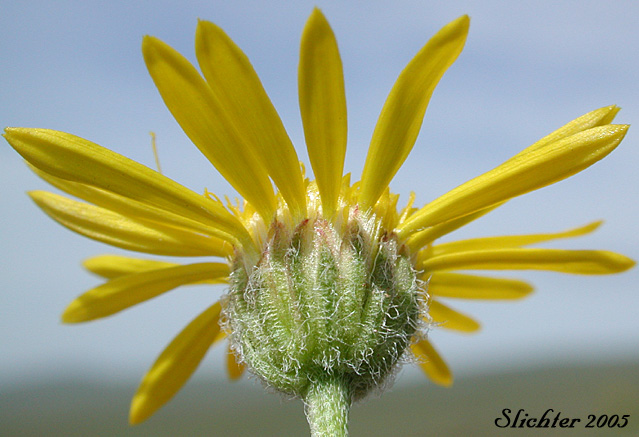 The photo at right shows a close-up of the underside of the flower head of yellow
desert daisy. Note the numerous spreading hairs on the involucral bracts.
Photographed atop the crest of the Columbia Hills in the Columbia
River Gorge.........May 1, 2005.
The photo at right shows a close-up of the underside of the flower head of yellow
desert daisy. Note the numerous spreading hairs on the involucral bracts.
Photographed atop the crest of the Columbia Hills in the Columbia
River Gorge.........May 1, 2005.
Yellow desert daisy is a cushion plant with many linear leaves and short upright flowering stems from 5-20 cm high. The herbage consists of fine gray hairs which are all straight and lie in the same direction appressed to the stem. The leaves are al linear in shape with entire margins, ranging from 1.5-9 cm long and 0.5-3 mm wide. The leaves are either entirely basal or occasionally mostly basal with a few stem leaves.
Each stem has a single quarter-sized flower with yellow disk and yellow rays. The 15-45 ray flowers measure from 4- 11 mm long while the central disk ranges from 8-13 mm wide. The disc flowers measure from 3.5- 5.3 mm long. The leaves and stems are finely gray-haired. The involucre is 4-7 mm high with fine, straight and flattened hairs or occasionally finely glandular.
Yellow desert daisy flowers from May to June.
Found in dry, rocky soil, often with sagebrush, from the lowlands to 2500 m in the foothills and lower mountains.
Mostly east of the Cascades and Sierra Nevada, from southern British Columbia to Yosemite National Park, east to western Wyoming and Montana.
In the Columbia River Gorge, yellow desert daisy is found along the crest of the Columbia Hills east of Dallesport, WA.
This is a beautiful species which would look very pleasing in a winter-protected (at least west of the Cascades) rock garden. I have 3 separate plants which have now survived for two years. They bloom over 4-6 weeks so provide some late spring and summer color in the rock garden. Being small however, they are susceptible to being overgrown by other larger plants. Give them at least a foot and a half distance from the nearest plants.